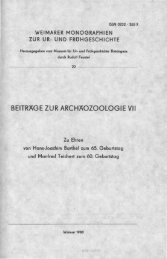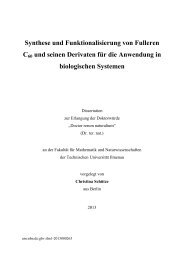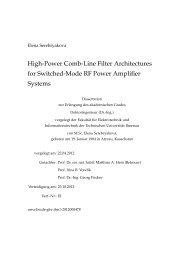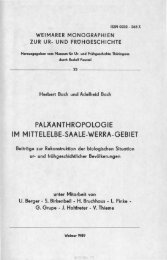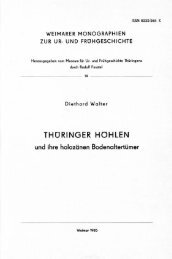Dissertation
Dissertation
Dissertation
You also want an ePaper? Increase the reach of your titles
YUMPU automatically turns print PDFs into web optimized ePapers that Google loves.
|3.1 Brominated Phenanthrolines - A Gate to new Bridging Ligands|<br />
with inequivalently halogenated tpphz derivatives that halogenation causes lower coordination<br />
affinity at the brominated phenanthroline sphere due to the electron withdrawing effect of these<br />
groups. This results in a selective ruthenium coordination into the unsubstituted N,N’ pocket of<br />
tpphz.<br />
[125, 126]<br />
Furthermore, it is known from experiments by Rau et al. that 3,5,6,8-tetrabromophenanthroline<br />
(phenBr 4 ) has a low coordination tendency toward ruthenium. [127] The attempts to prepare the<br />
series [Ru(tbbpy) 3-n (phenBr 4 ) n<br />
] 2+ (n = 1,2,3) succeeded only for n = 1 while the intermediates and<br />
products toward the complexes with n = 2, 3 could not be prepared (even with longer reaction<br />
times) or isolated, so that their characterization remains incomplete.<br />
In the first attempt, simple model complexes were prepared which consist of a number of the<br />
well known, solubility providing 4,4’-tert-butyl-2,2’-bipyridine (tbbpy) ligands at the ruthenium<br />
center and a brominated ligand for metalorganic coupling reactions (see figure 44).<br />
2+<br />
N<br />
N<br />
N<br />
Ru<br />
N<br />
Cl<br />
Cl<br />
+<br />
N<br />
N<br />
Br<br />
R<br />
MW, 2h, reflux<br />
(EtOH/H 2 O)<br />
N<br />
N<br />
N<br />
Ru<br />
N<br />
N<br />
N<br />
Br<br />
R<br />
R = H, Br<br />
Figure 44: Synthesis of the ruthenium complexes with one phenBr-type ligand.<br />
The synthesis of heteroleptic ruthenium polypyridine complexes of the type [Ru(̂LL) 2 (̂LL ′ )] 2+<br />
is typically achieved from the cisoidal dichloro complex [Ru(̂LL) 2 Cl 2 ] and can be performed<br />
according to the procedure of the work group of Rau et al. (method C1). Thereby a special<br />
microwave reaction was used which allows for high yields and short reaction times. [120]<br />
First, the starting materials [Ru(tbbpy) 2<br />
Cl 2 ] and tbbpy were prepared according to the mentioned<br />
procedures. Then, following the protocol of method C1, one equivalent of brominated<br />
phenanthroline derivative was used in a microwave reaction together with [Ru(tbbpy) 2<br />
Cl 2 ] to<br />
prepare the desired complexes. The end of the reaction was indicated by a color change from<br />
dark purple to bright red after refluxing the mixture for two hours in ethanol/water (4:1). Directly<br />
|64|



